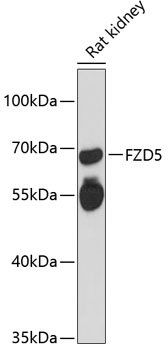-
Product Name
FZD5 Polyclonal Antibody
- Documents
-
Description
Polyclonal antibody to FZD5
-
Tested applications
WB
-
Species reactivity
Rat
-
Alternative names
FZD5 antibody; C2orf31 antibody; HFZ5 antibody; frizzled-5 antibody
-
Isotype
Rabbit IgG
-
Preparation
Antigen: Recombinant fusion protein containing a sequence corresponding to amino acids 130-240 of human FZD5 (NP_003459.2).
-
Clonality
Polyclonal
-
Formulation
PBS with 0.02% sodium azide, 50% glycerol, pH7.3.
-
Storage instructions
Store at -20℃. Avoid freeze / thaw cycles.
-
Applications
WB 1:500 - 1:2000
-
Validations

Western blot - FZD5 Polyclonal Antibody
Western blot analysis of extracts of rat kidney, using FZD5 antibody at 1:3000 dilution.Secondary antibody: HRP Goat Anti-Rabbit IgG (H+L) at 1:10000 dilution.Lysates/proteins: 25ug per lane.Blocking buffer: 3% nonfat dry milk in TBST.Detection: ECL Enhanced Kit .Exposure time: 90s.
-
Background
Receptor for Wnt proteins. Can activate WNT2, WNT10B, WNT5A, but not WNT2B or WNT4 (in vitro); the in vivo situation may be different since not all of these are known to be coexpressed (By similarity). In neurons, activation of WNT7A promotes formation of synapses. Functions in the canonical Wnt/beta-catenin signaling pathway. The canonical Wnt/beta-catenin signaling pathway leads to the activation of disheveled proteins, inhibition of GSK-3 kinase, nuclear accumulation of beta-catenin and activation of Wnt target genes (By similarity). A second signaling pathway involving PKC and calcium fluxes has been seen for some family members, but it is not yet clear if it represents a distinct pathway or if it can be integrated in the canonical pathway, as PKC seems to be required for Wnt-mediated inactivation of GSK-3 kinase. Both pathways seem to involve interactions with G-proteins. May be involved in transduction and intercellular transmission of polarity information during tissue morphogenesis and/or in differentiated tissues (Probable). Plays a role in yolk sac angiogenesis and in placental vascularization (By similarity).
Related Products / Services
Please note: All products are "FOR RESEARCH USE ONLY AND ARE NOT INTENDED FOR DIAGNOSTIC OR THERAPEUTIC USE"
